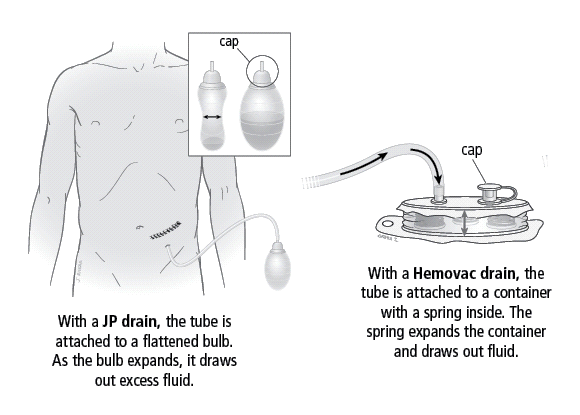What is a suction drain?
A suction drain is a device that gently pulls fluid from your body. It’s used to prevent extra fluid from building up in your body after surgery or if you have an infection.
The suction drain has a thin flexible tube attached to a squeezable container. One end of the tube is inserted in the area of your body where the fluid is building up. The other end is attached to the flattened container. As the container expands, it draws out the excess fluids. Two common types of suction drains are:
- JP drain (also called a Jackson Pratt drain), which suctions the fluid into a squeezable bulb
- Hemovac drain, which suctions the fluid into a flat container with springs inside
The suction drain will stay in place until the amount of fluid slows or stops.

How do I empty the bulb?
Check the amount of fluid in the container every 2 to 4 hours. Empty it when the container is half full, or every 8 hours, whichever comes first. As you heal, the amount of fluid will get smaller, and you’ll need to empty it less often. Follow these steps:
- Set out your supplies, including a measuring cup, an alcohol wipe, and a pen or pencil.
- Wash your hands with soap and water.
- Remove the cap or open the plug of the container. Do not touch the inside of the cap or plug.
- Empty the fluid into the measuring cup.
- Clean the cap or plug with an alcohol wipe.
- Squeeze the container and hold it flat. While it’s flat, put the cap or plug back on. If you can’t flatten it and close it at the same time, ask someone for help.
- Measure and record how much fluid you collected. Write down the date, time, and amount of fluid. A record chart is on page 2 of this fact sheet. Be sure to bring the record to your next appointment.
- Flush the fluid down the toilet. Rinse the measuring cup.
- Wash your hands with soap and water.
How do I protect my skin?
The skin at the place where the tubing enters your body needs to stay clean to prevent infection. Change the dressing over the area every day. Follow these steps:
- Wash your hands with soap and water.
- Remove the dressing and throw it away.
- Clean the area with an alcohol wipe or with saline solution.
- Check for signs of infection listed below. If you see any of these, contact your healthcare provider.
- Place a new dressing around the tubing.
- Tape the tubing in place against your skin.
- Wash your hands with soap and water.
- Safety pin the drain to your dressing or clothes.
When should I call for help?
Contact your healthcare provider if you experience any of the following:
- Signs of infection, including:
- Increased redness, pain, or swelling
- Fever greater than 101° F (38.4° C)
- Cloudy, yellow, or bad-smelling drainage
- Trouble with the drain, including:
- The container will not stay flat
- The tubing is clogged
- The amount of drainage increases suddenly, or fluid is leaking onto your skin
- The tubing comes out of your skin, or comes unhooked from the container
- The stitches holding the tubing in place come out